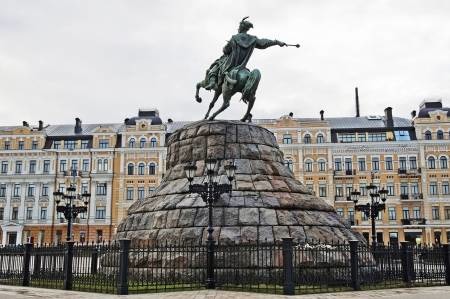Back to Solzhenitsyn index
Back to article index
Previous
THE KHMELNITSKY UPRISING

The Khmelnitsky monument in Kiev
This Polish idyll was severely shaken in 1648 with the Cossack uprising led by Bogdan Khmelnitsky which entailed large scale massacres of Poles and Jews and eventually, after many twists and turns involving Sweden, Lithuania, Transylvania, the Crimean Tatars, even the Ottoman Empire, resulted in Eastern Ukraine, including Kiev, being incorporated into Russia, at first on a semi-autonomous basis as a Cossack 'hetmanate', a development which could be seen as the beginning of Russia's conversion into a Russian Empire.
I don't entirely understand why, then, 1667, rather than 1772, should not be regarded as the date on which a substantial Jewish population was incorporated into the Russian Empire. According to the Wikipedia entry on 'History of the Jews in Kiev': 'After the Russian occupation in 1654, Jews were not allowed to settle in the city. This ban was lifted only in 1793 after the third partition of Poland' [sic. the third partition was, as we have seen, in 1795]. Poliakov says that between 1648 and 1668 'no Jew remained on the left bank of the Dnieper - those who were spared were sold as slaves to the Turks ... the total number of victims [in the whole area, including the right bank - PB] rose to several tens of thousand, perhaps to 100,000 ...' (p.399). The Dnieper became the frontier line between what was left of Poland after 1667 and the Russian Empire (somewhat confusingly, the 'left bank of the Dnieper' is the area to the East, towards Russia. When we look at the map it's the area to the right). Nonetheless Poliakov also says that in 1727, when Catherine I (widow and successor of Peter 'the Great', not to be confused with Catherine II 'the Great') wanted to expel the Jews from Ukraine and Russia 'it concerned those Jewish shopkeepers and artisans whose rootedness in the local economic life I have already described. Under these conditions, as soon as they tried to expel them, serious complications arose and the civil and military authorities were obliged to grant numerous exceptions to avoid a more serious disruption.' (p.420). So they were still there. Solzhenitsyn, incidentally, describing the same event - Catherine's attempt to expel the Jews - simply states that it didn't last very long, without giving reasons.
Nonetheless the Khmelnitsky rising had a huge impact on the Jews, economically and culturally, in Poland and Polish Ukraine: 'From the second half of the seventeenth century they were no longer the principal bankers of the country - this role passed to Christian capitalists, above all the religious communities, churches and monasteries, whose wealth, mainly in land, had remained intact. The Jews, both communities and individuals, were in debt to them; the chronic indebtedness of the kahals, through their desperate efforts to refloat the Jewish economy, became a major social problem for Poland and continued to get worse through to the end of the eighteenth century. In 1765, the Polish diet suppressed the 'Council of the Four Lands', the Jewish federating organisation, finding it easier to impose on Jews, instead of the old global tax, a poll tax of two zlotys a head. So ended the Jewish semi-state autonomy ...' Seeking the means of making a living, many Jews 'installed themselves in rural areas as innkeepers, tavern keepers, artisans or peddlers, most of them living in extreme poverty.' (Poliakov, p.400).